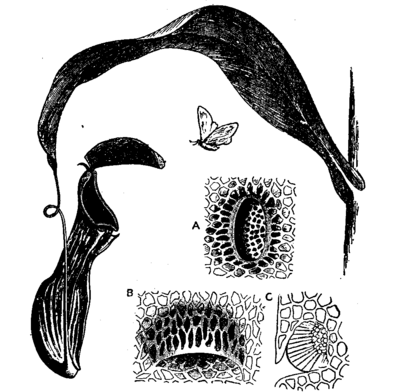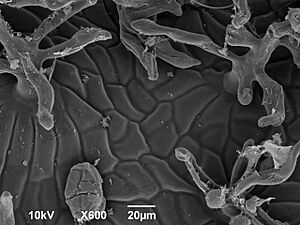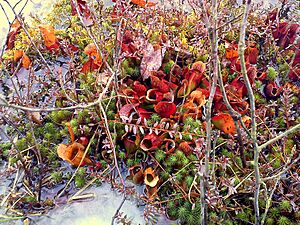Pitcher plant facts for kids
Pitcher plants are amazing carnivorous plants that catch their food using a special trap called a pitfall trap. This trap is like a deep cup or pitcher filled with a liquid that helps digest insects. These "pitchers" are actually special leaves that have changed over time to become traps. The plants attract insects with sweet nectar, and then the insects fall into the pitcher and get trapped.
Contents
Types of Pitcher Plants
When people talk about "pitcher plants," they usually mean plants from two main families: Nepenthaceae and Sarraceniaceae. But there are also a few other plants, like those in the Cephalotaceae family and some Bromeliaceae (like pineapples!), that also have pitfall traps. The Nepenthaceae and Sarraceniaceae families have the most types of pitcher plants.
Old World Pitcher Plants
The Nepenthaceae family has only one genus called Nepenthes. There are over 100 different kinds of Nepenthes plants, plus many mixes and types grown by people. These are often called "Old World" pitcher plants because they come from places like Asia and Australia.
Their pitchers grow at the end of long, thin parts called tendrils, which come from the middle of a regular leaf. These plants often climb high into the trees using their tendrils, like vines. Some also grow on the ground in forest clearings or on other trees as epiphytes. Their pitchers are usually round and have a waxy coating inside to make them extra slippery.
New World Pitcher Plants
The Sarraceniaceae family includes "New World" pitcher plants, found in North and South America. These plants grow from a root that spreads sideways underground, called a rhizome. Unlike Nepenthes, the whole leaf of these plants forms the pitcher.
There are three main groups in this family:
- Marsh Pitchers (Heliamphora): These plants have a simple, rolled-up leaf that forms the pitcher. At the very tip, there's a spoon-like part that makes nectar. You can find them in rainy parts of South America.
- Trumpet Pitchers (Sarracenia): These are found in North America. Their traps are more complex than Heliamphora. They have a lid, called an operculum, which helps stop too much rainwater from filling the pitcher. The Sarracenia purpurea, also known as the purple pitcher plant, is the special flower of Newfoundland and Labrador, Canada.
- Cobra Plants (Darlingtonia): There's only one type of cobra plant, found in California. It's called the cobra plant because its pitcher looks like a cobra snake ready to strike! It has a puffed-up "lid" with clever fake exits and a forked "tongue" that guides ants and other insects right into the trap.
Australian Pitcher Plant
The Cephalotaceae family has only one plant: Cephalotus follicularis. This plant has small pitchers, about 2–5 cm long, that look a bit like Nepenthes pitchers. But in Cephalotus, the stem of the leaf is attached to the back of the trap's rim, not the bottom. This unique plant only grows in one area in southwestern Australia.
Carnivorous Bromeliads
A few types of bromeliads, like Brocchinia reducta and Catopsis berteroniana, are also thought to be carnivorous. Bromeliads are a family of plants that include pineapples.
How Pitcher Plants Catch Food
Pitcher plants are very clever at attracting, catching, and digesting insects.
Attracting Prey
Insects like flies are drawn to the pitcher's opening. The plants use different tricks to get their attention:
- Colors: Many pitcher plants have bright colors, like red or purple, from pigments called anthocyanins. Some even have patterns that glow under ultraviolet light, which insects can see.
- Smell: Some pitcher plants, like Nepenthes rafflesiana, give off smells that copy flower scents to attract insects.
- Nectar: A sweet, sticky liquid called nectar is often found around the rim of the pitcher, luring insects closer.
Capturing Prey
Once an insect lands on the rim of the pitcher, it's in trouble!
- Slippery Rim: The rim, called the peristome, becomes very slippery when it's wet from dew or nectar. This makes insects lose their footing and fall inside.
- Slippery Walls: The inside walls of the pitcher can be covered with waxy scales, tiny hairs pointing downwards, or other slippery surfaces. These make it almost impossible for insects to climb back out.
- Liquid Pool: At the bottom of the pitcher is a pool of liquid. This liquid, called phytotelmata, drowns the insect.
Digestion
After the insect drowns, its body is slowly broken down. This can happen in a few ways:
- Bacteria: Some pitchers rely on bacteria that get washed into the trap by rain. These bacteria help break down the insect.
- Plant Enzymes: Other pitcher plants make their own special liquids, called enzymes, that dissolve the insect's body.
- Liquid Properties: The liquid in the pitchers can be thick or thin, and more or less acidic. This helps them catch different types of prey. For example, thicker liquid might be better for catching flying insects, while more acidic liquid can quickly kill crawling insects like ants.
- Helpers: Some pitcher plants even have tiny insect larvae living in their pitchers. These larvae eat the trapped prey, and then the plant absorbs the waste from the larvae!
No matter how they digest their prey, the insects are turned into a soup of useful nutrients like amino acids, phosphates, and nitrogen. Pitcher plants usually grow in places where the soil is very poor in minerals or too acidic for most plants to grow. By eating insects, pitcher plants get the extra nutrients they need to survive and grow, especially nitrogen and phosphorus, which plants normally get from their roots.
How Pitcher Traps Evolved
Scientists believe that pitcher traps developed over a very long time. They think that regular leaves slowly folded inwards, becoming deeper and deeper cups. This happened because plants with deeper cups were better at catching insects, helping them survive and pass on their traits.
What's really cool is that pitcher traps evolved independently in different groups of plants. This means the ability to form a pitcher trap appeared separately in different plant families, even though they aren't closely related. This is a great example of convergent evolution, where different species develop similar features because they face similar challenges.
Images for kids
-
Most North American pitcher plants belong to the genus Sarracenia.
-
Cobra lilies (Darlingtonia californica) use window-like areolae to lure insects into their hollow leaves.
-
The Australian pitcher plant is the only member of the Australian genus Cephalotus.
See also
 In Spanish: Planta odre para niños
In Spanish: Planta odre para niños
- Darlingtonia State Natural Site – A special nature area in Oregon, United States, where pitcher plants are protected.
- Baghmara Pitcher Plant Wildlife Sanctuary










